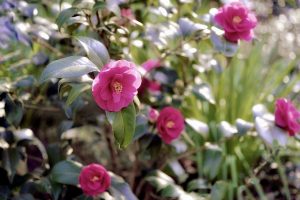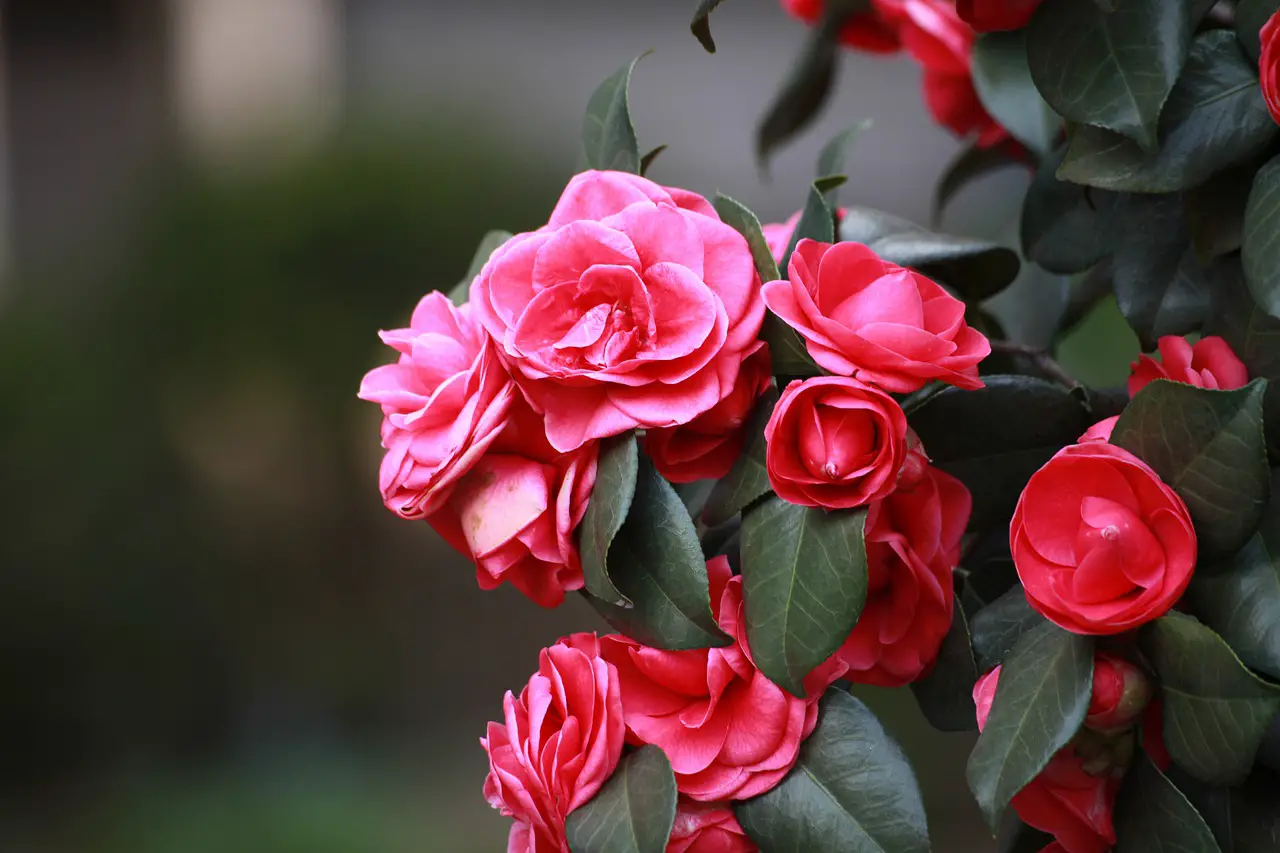Last Updated on April 15, 2024 by Real Men Sow
Camellias are evergreen shrubs that bear attractive flowers in the late winter and early spring. To establish, camellia varieties need to be watered regularly for the first two years. They are capable of taking care of themselves after that. Camellias can be healthy by being in the right place and maintaining good soil conditions.

Things To Know About Camellias Before Growing Them
- They need soil that is neutral to acidic. They won’t grow well in chalky soils
- These plants should be grown in a semi-shady position that is protected from strong wind. If flowers are planted in the east, they can easily be damaged.
- In dry weather, especially from July through September, younger plants will require watering. Camellias with more experience are better at managing water.
- Although tap water is safe to use occasionally, they prefer more acidic water, which is rainwater.
- The majority of flowers bloom in late winter and early spring. Camellia sasanqua flowers mid-autumn
- Some varieties can be grown in large containers.
- The maturity size and spread can vary from 2m/6ft to 10m/32ft, so be sure to choose the right variety!
Planting Camellia Varieties
Although autumn is the best season to plant new camellia varieties, they can also be planted in spring as long as the roots remain moist until the weather warms up.
You should choose a semi-shady location. Shade, if possible should be used to protect plants from the morning sun. The combination of a frosty night with a sun-filled morning is what really harms camellia flowers and buds. It is the sudden transition from cold to warmth that is most dangerous. You should also choose a location that is protected from strong wind.
If possible, the soil should be slightly acidic. Although neutral soil can sometimes be improved with the addition of ericaceous soil, alkaline or chalky soils will be detrimental to the health of your camellia. Dig a hole twice the size of your root ball to plant a new camellia. To half-fill the hole, add some ericaceous soil and a few blood fish and bones then use a trowel to mix the bone, blood, and fish into the soil at its base.
The camellia should be planted at the same depth it was in its pot. Firmly firm it into the soil. To support the plant for the first few years, you will need to place a stake in the ground. They are susceptible to being blown away by strong winds. Attach the camellia to your stake. Water in well.
If necessary, provide rabbit protection. Camellia plants are loved by rabbits, especially young ones. Wire mesh around the plant’s base is the best protection. After two to three years, the stake can be removed.
Taking Care of Camellia Varieties
Camellias are relatively easy to care for after they have established, but they will need to be maintained for the first few years of their lives.
How to care for Camellia
Two key requirements are regular water supply at certain times throughout the year, and good nutrition in the spring and summer. These are especially important during the first three years of a plant’s existence. After that, the roots will be sufficiently large and deep to take care of themselves in any dry conditions.
Watering Camellia varieties
Camellias in their native countries (China Japan South Korea), receive a lot of rain from spring through summer, but very little from mid-autumn through the following year. You can try to replicate this need in your garden. If the weather is dry in the UK, plants will need to be watered from the beginning of the year through the end of the season. Plants in dry areas, such as Australia or the USA, may require more frequent watering.
In early July, the flower buds begin to develop for next year. This is also the critical period for water. Flowers that are not hydrated at this time will suffer for the rest of the year.
Rainwater is the best water for Camellias and prefers slightly acidic soil. Tap water is alkaline, so it is not the best water source for acid-loving plants. A waterbutt collecting rain is the best option if you need to water often or live in low rainfall areas. The plants won’t be affected by occasional tap water use, but they will be damaged if it is used continuously.
Feeding Camellia Plants
Young camellia varieties require water and two handfuls of bone, blood, and fish should be given to each plant twice a year in spring and early-summer. Avoid quick fix nitrogen fertilisers as they can promote the growth of many weak leaves. You should not feed your plants between mid-August and late January.
The plants should be capable of caring for themselves in the UK once they reach three to four years old. A good soaking with water in hot and dry summers will encourage buds to form and support growth over the next year.
Pruning Camellia
It is best to prune camellias immediately after they have dipped in spring. Although you can prune later in a year, it is best to do so immediately after the flowers have wilted.
Your camellia will not need to be pruned for the first four years. It’s better to let it grow strong on its own. Then, you should do two more pruning each year.
- Remove all stems from the main trunk’s lower portion. This will ensure that the main stem’s lower 15cm-25cm (depending on how tall the plant is) is free of growth. This will prevent the stems from touching the ground or picking up any diseases.
- Remove any wispy or thin growth from the center of the plant. This will keep the central area clear of congestion and improve air circulation.
Other pruning options include keeping the plant in the shape you desire and at the right size. A camellia established will tolerate any drastic pruning that has no long-term effects. You can shape your camellia by pruning as you wish. There is no special technique.
Camellias in Pots and Containers
Although Camellias can grow in containers and pots, they will need to be cared for in winter. The frost damage to potted plants is more severe than that in the ground. Place your Camellias pots then move them to a porch or open garage, or somewhere up against the house in winter. You can temporarily move them into a garage if it is really cold. Although it isn’t ideal, the lack of sunlight will not have any visible effects if it is limited to a few days.
Another consideration when growing Camellias indoors is the size of your pots. This includes both the size and the shrub. Because large containers are more difficult to water, they require less attention.
Use a container of approximately 40cm (16in) to plant in ericaceous soil. In warm weather, container grown plants can dry out quickly and may require watering twice a week.
Each month, a handful of bone, fish, and blood fertiliser will be sufficient to provide nutrients for healthy plants. Long-lasting feed for acid-loving plants is an excellent alternative. You should avoid normal nitrogen fertilizers.
Camellias placed in containers need to be watered regularly with rain water to retain the acidity of their compost. Tap water is an option in emergencies, but it is better than allowing plants to dry out.
Pests and Diseases
Camellias are generally healthy plants and any pests or problems that they may have are fairly easy to fix.
Sooty Mould For Camellias
These symptoms are easy to recognize. The leaves become blackened and covered with a substance that looks sooty. This usually occurs between late April and late June.
Scale insects on camellias are most commonly responsible. As they feed on the leaves, these insects secrete a sticky sweet substance. It settles, attracts fungi and causes the black sooty substance. It is not very noticeable, but it rarely causes any significant damage.
If you only have a small camellia plant, the best way to get rid of them is to wash them off with a little soapy water. Use a few drops of dishwashing liquid per pint. You can spray larger plants with water to get rid of many of the aphids as well as some of the sooty mold. You can find more information about aphids in our article .
Leaf Blight
The symptoms include light to dark brown areas around the leaves, usually starting at the tip of the leaf and continuing up to the stem. The brown areas look slightly oily. The affected leaves will eventually fall off.
This fungal disease does not have a cure, but it can attack plants that are weak in damp environments. This is the best way to proceed:
- Burn infected leaves and fallen material under the plant.
- Allow good air circulation to the centre of your plant, and you can avoid damp conditions. Remove any wispy or thin growth from the center of the plant.
- Follow the watering and feeding instructions in this article to keep your plant healthy.
Flower Blight For Camellia Varieties
These are dark to brown spots on the petals. These usually appear at the petals’ edges. However, within 36 hours they will spread to the center of the flower. Shortly thereafter, they will disappear. There is no treatment.
Fungal infections are caused by spores that can travel for miles on the wind. They can also travel on shoes and gardening implements. Although this is a very difficult problem to treat, the following tips may help.
- The spores are caused by fungi that grow vigorously in soil. You can create a barrier between the plant and the soil using newspaper, cardboard or other similar materials. Then cover it with mulch of 5cm/ 2in. This will prevent fungi from growing and may even kill them in a few years. Repeat this five times each year.
- Burn infected leaves and fallen material under the plant.
- Allow good air circulation to the centre of your plant, and you can avoid damp conditions. Remove any wispy or thin growth from the center of the plant.
- Follow the watering and feeding instructions in this article to keep your plant healthy.


